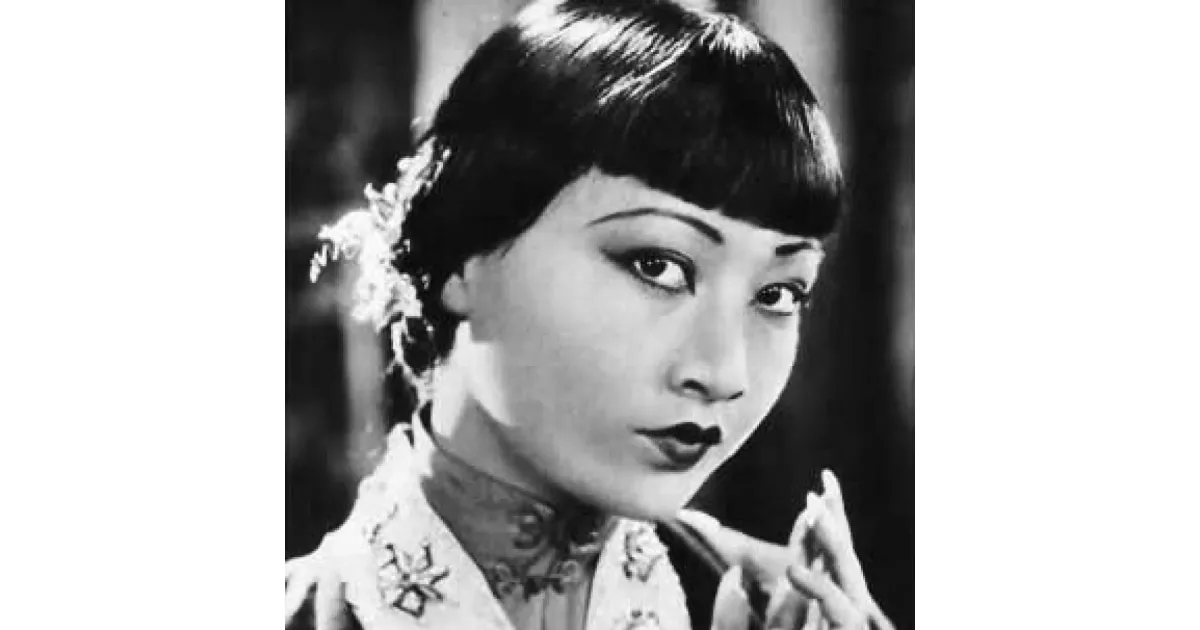Anna May Wong, born Wong Liu Tsong, was a pioneering Chinese American actress who achieved international fame in the early 20th century. Her illustrious career spanned various mediums including silent films, talkies, television, theater, and radio. She is recognized as the first Chinese American movie star in Hollywood and the first to achieve global recognition, breaking barriers and paving the way for greater representation in the entertainment industry.
1901: Marriage of Anna May Wong's Parents
Anna May Wong's father, after returning to the U.S. and while still supporting a family in China, married her mother in 1901.
1902: Birth of Lew-ying (Lulu) Wong
Anna May Wong's older sister, Lew-ying, also known as Lulu, was born in 1902.
January 3, 1905: Birth of Anna May Wong
Anna May Wong, originally Wong Liu Tsong, was born on January 3, 1905.
1905: Birth of Anna May Wong
Anna May Wong was born in 1905.
1907: Birth of James Wong
Anna May Wong's younger brother, James, was born in 1907 and passed away in 1971.
1910: Birth of Mary Wong
Anna May Wong's younger sister, Mary, was born in 1910 and passed away in 1940.
1910: Move and Educational Experiences
Wong's family relocated to a new neighborhood in 1910. She initially attended public school but later switched to a Presbyterian Chinese school due to racial taunts. She also attended Chinese language classes.
1912: Birth of Frank Wong
Anna May Wong's younger brother, Frank, was born in 1912 and died in 1989.
1915: Birth of Roger Wong
Anna May Wong's younger brother, Roger, was born in 1915 and passed away in 1983.
1919: First Acting Role
Anna May Wong secured her first acting role as an extra in the film "The Red Lantern" in 1919.
1919: Birth and Death of Marietta Wong
Anna May Wong's younger sister, Marietta, was born and passed away in 1919.
1919: Uncredited Role in "The Red Lantern"
While working at a department store, Wong got an uncredited role in Alla Nazimova's film "The Red Lantern" in 1919.
1920: Death of Marietta Wong
Marietta Wong, one of Anna May Wong's sisters, died in 1920.
1921: Pursuit of a Full-Time Acting Career
In 1921, Wong decided to pursue acting full-time, leaving Los Angeles High School to focus on her career.
1921: First Screen Credit in "Bits of Life"
Wong received her first screen credit for her role in the anthology film "Bits of Life" in 1921.
1922: Birth of Richard Wong
Anna May Wong's younger brother, Richard Wong, was born in 1922 and passed away in 2007.
1922: Role in "The Toll of the Sea"
Wong starred in "The Toll of the Sea" in 1922, one of the first films produced in color.
1923: Continued Supporting Roles and Optimism
Despite Hollywood's limitations, Wong continued to take on supporting roles in 1923, remaining optimistic about her future in film.
March 1924: Anna May Wong Productions and Cultivating a Flapper Image
In March 1924, after moving into her own apartment, Anna May Wong decided to create her own production company called Anna May Wong Productions with plans to make films about Chinese myths. During this time, she also started to cultivate a flapper image, likely as a way to appeal to American audiences who saw her as "foreign-born". However, her business partner was found to be dishonest, forcing Wong to file a lawsuit and dissolve the company.
1924: International Stardom and Fashion Icon
By 1924, Wong achieved international stardom and became a recognized fashion icon, embracing the flapper look.
1924: Exotic Supporting Roles and "Vamp" Stereotype
In 1924, Anna May Wong continued to be offered exotic supporting roles that perpetuated the rising "vamp" stereotype in cinema. She played indigenous native girls in two films, "The Alaskan" as an Eskimo, and "Peter Pan" as Princess Tiger Lily.
1924: Breakthrough Role in "The Thief of Bagdad"
Wong's supporting role in the 1924 Douglas Fairbanks film "The Thief of Bagdad" brought her significant attention and furthered her career.
1925: Critical Praise and Disappointment
By 1925, Anna May Wong received critical praise for her performance in the film "Forty Winks." Despite positive reviews, she grew increasingly disappointed with being typecast and sought other paths to success. She briefly toured the vaudeville circuits with a group of serial stars, but the tour failed, prompting their return to Hollywood.
1926: Grauman's Chinese Theatre Groundbreaking and "The Silk Bouquet"
In 1926, Anna May Wong participated in the groundbreaking ceremony for Grauman's Chinese Theatre with Norma Talmadge. She also starred in the film "The Silk Bouquet" that year, later renamed "The Dragon Horse." Notably, the film was one of the first U.S. films to be produced with backing from the Chinese Six Companies in San Francisco.
1927: Stereotypical Roles and Censorship Challenges
During 1927, Anna May Wong continued to be typecast in supporting roles that reflected the stereotypical portrayals of Asian women in Hollywood at the time. She played a "Dragon Lady" in the film "Old San Francisco" and was denied a lead role in "Mr. Wu" due to the increasing censorship against mixed-race on-screen couples. This type of discrimination would unfortunately continue throughout her career.
March 1928: Move to Europe for Better Opportunities
Frustrated with stereotypical roles in Hollywood, Wong moved to Europe in March 1928 to seek better acting opportunities.
1928: European Sensation and Critical Acclaim
Anna May Wong's career flourished in Europe in 1928 as she starred in films like "Schmutziges Geld". Her performances received critical acclaim, even leading The New York Times to praise her as an actress of "transcendent talent" and "great beauty".
1928: Leaving Hollywood for Europe
Frustrated by the lack of complex roles and the prevalence of typecasting in Hollywood, Anna May Wong made the decision to leave for Europe in 1928 to seek better opportunities and more diverse roles.
1929: European Success with "Pavement Butterfly"
Anna May Wong's success in Europe continued in 1929 as she starred in the film "Großstadtschmetterling", known as "Pavement Butterfly" in English.
1929: "Piccadilly" Success and Sensual Role
In 1929, Anna May Wong starred in her final silent film, "Piccadilly", which became a sensation in the UK. Although Gilda Gray was the lead actress, Wong's performance was praised by critics, including Variety, who noted that she "outshines the star." Despite the film's success and Wong's standout performance, she was once again denied the opportunity to kiss her white love interest due to racial prejudices of the time, leading to the controversial decision to cut a planned kissing scene before the film's release.
1929: Starring Role in "Piccadilly"
Wong starred in the notable play "Piccadilly" in 1929.
November 1930: Tragic Loss of Mother
In a tragic turn of events, Anna May Wong's mother was struck and killed by an automobile in November 1930 in front of their home. This devastating loss deeply affected Wong and the entire family.
1930: Multilingual Performance in "Der Weg zur Schande" & Stage Success with "Tschun Tschi"
In 1930, Anna May Wong further demonstrated her talent and versatility by starring in the film "Der Weg zur Schande" ("The Road to Dishonour"). That same year, she achieved success on the stage, performing the title role in the operetta "Tschun Tschi" in Vienna, Austria, where her fluency in German and captivating performance earned her rave reviews.
1930: "The Flame of Love" and Multilingual Performance
In 1930, Anna May Wong starred in her first talkie, "The Flame of Love", showcasing her multilingual skills by performing in French, English, and German. Although her performance, particularly her command of the three languages, was praised, the film itself received negative reviews.
1930: Return to Hollywood and Broadway Debut
Lured back to Hollywood in 1930 by Paramount Studios with promises of lead roles and top billing, Anna May Wong made her Broadway debut in the play "On the Spot". The play, a drama that ran for 167 performances and would later be adapted into the film "Dangerous to Know", showcased Wong's talent to a wider audience and further solidified her reputation as a versatile performer. Wong's return to the United States marked a pivotal point in her career, even though her experiences with racism and typecasting unfortunately continued.
1930: Hays Code Established
The Hays Code, which included guidelines for film content, was established in 1930.
1931: "Daughter of the Dragon" and Pay Disparity
In 1931, Anna May Wong starred in "Daughter of the Dragon", playing the lead role of Fu Manchu's vengeful daughter. This marked the last time Wong played a stereotypical "evil Chinese" role. The film was also significant because it paired her with Sessue Hayakawa, another well-known Asian actor of the time. Despite being given top billing, Wong's salary of $6,000 was significantly lower than her male counterparts: Hayakawa received $10,000, and Warner Oland, who had a limited role with only 23 minutes of screen time, was paid $12,000. This pay disparity highlights the gender inequality and discrimination that Wong faced in Hollywood.
1931: Wong's Political Advocacy and Criticism of Stereotypes
In 1931, Anna May Wong used her platform to criticize the Mukden Incident and advocate for Chinese-American causes, challenging stereotypical film roles and speaking out against the negative portrayal of Chinese people in films like Daughter of the Dragon.
1931: Reflection on Career Choice
In 1931, Wong reflected on her decision to pursue acting, expressing a belief in taking chances and pursuing passions.
1931: Publication of The Good Earth and Wong's Aspiration for O-lan Role
Since the publication of Pearl Buck's The Good Earth in 1931, Anna May Wong had expressed a strong desire to portray the lead female character, O-lan, in a film adaptation.
1931: Appearance in "Daughter of the Dragon"
Wong appeared in the film "Daughter of the Dragon" in 1931.
1932: Collaboration with Marlene Dietrich
In 1932, Wong acted alongside Marlene Dietrich in Josef von Sternberg's film "Shanghai Express."
1932: Mixed Reactions to Shanghai Express and Honorary Doctorate
While the Chinese press, particularly the Nationalist government, criticized Anna May Wong's performance in Shanghai Express for allegedly perpetuating negative stereotypes of Chinese women, she received an honorary doctorate from Peking University in 1932, possibly the first time an actor received such an honor.
1933: Los Angeles Newspapers Support Wong for O-lan Role
By 1933, Los Angeles newspapers were advocating for Anna May Wong to be cast as O-lan in the film adaptation of The Good Earth, recognizing her as the ideal choice for the role.
1933: Wong Passed Over for Roles in The Son-Daughter and The Bitter Tea of General Yen
Despite her talent and experience, Anna May Wong continued to face discrimination in Hollywood. In 1933, she was deemed "too Chinese" for a leading role in The Son-Daughter and lost the part in The Bitter Tea of General Yen to Toshia Mori.
1933: Wong's "I Protest" Interview
In a 1933 interview for Film Weekly titled "I Protest," Anna May Wong criticized the film industry's practice of portraying Chinese characters as villains, highlighting the discrepancy between these representations and the reality of Chinese civilization.
1933: Speaking Out Against Typecasting
In a 1933 interview with Film Weekly, Anna May Wong spoke out against her stereotypical roles in Hollywood, expressing her frustration with the lack of opportunities for Asian actors and the industry's preference for non-Asian actors in Asian roles.
1934: Wong Stars in Java Head and Meets Mei Lanfang
Anna May Wong starred in Java Head in 1934, notable for featuring her only on-screen kiss with a white male lead. This year, she also met Mei Lanfang, a renowned Beijing Opera star, who offered to mentor her in Chinese opera.
1934: Wong Named "World's Best-Dressed Woman"
Anna May Wong was voted "The World's best-dressed woman" by the Mayfair Mannequin Society of New York in 1934, solidifying her status as a fashion icon.
1934: Wong's Father and Siblings Return to China
In 1934, Anna May Wong's father returned to his hometown in China, accompanied by her younger siblings.
1934: Family's Return to China
In 1934, Anna May Wong's father returned to his hometown in China, taking her younger siblings with him. Wong had been financially supporting her siblings' education, and they were able to utilize their education after relocating to China.
1934: Hays Code Revised
The Hays Code underwent revisions in 1934.
1934: Role in "Java Head"
Wong was featured in the film "Java Head" in 1934.
June 1935: Wong Returns to the U.S. Aiming for O-lan Role in The Good Earth
After achieving success in Europe, Anna May Wong returned to the United States in June 1935 with the aspiration of securing the role of O-lan in MGM's film adaptation of The Good Earth.
1935: Wong Tours Britain and Appears in King George Silver Jubilee Program
During her time in Britain, which lasted for almost three years, Anna May Wong participated in a vaudeville show that toured Scotland and Ireland. She also made an appearance in the King George Silver Jubilee program in 1935.
1935: Career Disappointment: "The Good Earth"
In 1935, Wong faced a major career setback when she was denied the lead role in the film adaptation of "The Good Earth" due to her ethnicity and the studio's decision to use a white actress in yellowface.
January 1936: Wong Embarks on a Trip to China and Addresses Marriage Rumors
Anna May Wong began her journey to China in January 1936, documenting her experiences for American newspapers. During a stopover in Tokyo, she dismissed rumors of marriage, stating her dedication to her craft, only for Japanese newspapers to publish a false story about her marriage to a man named "Art."
1936: Footage from China Trip Featured in Documentary
Footage from Anna May Wong's 1936 trip to China was incorporated into a documentary she hosted for the ABC travel series "Bold Journey" in 1956, marking one of the first U.S. documentaries on China narrated by a Chinese American.
October 1937: Wong Addresses Marriage Rumors with Philip Ahn
In October 1937, amidst rumors of a romantic relationship with her Daughter of Shanghai co-star Philip Ahn, Anna May Wong dismissed the possibility of marriage, stating that it would be like marrying her brother.
1937: Positive Chinese Roles in Hollywood Films
The rising popularity of Pearl Buck's novels and growing American support for China against Japanese imperialism led to the emergence of more positive Chinese roles in American films, such as in Daughter of Shanghai.
1937: Performance in "Daughter of Shanghai"
Wong appeared in the film "Daughter of Shanghai" in 1937.
1938: Wong Stars in Dangerous to Know
Anna May Wong starred in the film Dangerous to Know in 1938, a performance that received mixed reviews, with some critics finding the film itself underwhelming.
1938: Chinese Benevolent Association Honors Anna May Wong
In 1938, Anna May Wong was recognized by the Chinese Benevolent Association of California for her efforts in support of Chinese refugees. This followed her auctioning off her movie costumes and donating the proceeds to aid Chinese individuals.
1938: Wong Recognized as "World's Most Beautiful Chinese Girl"
In 1938, Look magazine named Anna May Wong "The World's most beautiful Chinese girl," further cementing her influence on fashion and beauty standards.
1938: Wong Reflects on Her Career and Her Father's Return to Los Angeles
Upon returning to Hollywood after her trip to China, Anna May Wong expressed her disillusionment with both Hollywood and the possibility of performing in Chinese theater. That same year, her father returned to Los Angeles.
1939: Advocacy for the Chinese Struggle Against Japan
Between 1939 and 1942, Anna May Wong's film appearances became less frequent as she dedicated her time to events and appearances advocating for the Chinese struggle against Japan.
1939: Seeking New Opportunities in Australia
Driven by her frustration with the restrictive typecasting in Hollywood, Anna May Wong embarked on a three-month trip to Australia in 1939, where she became a star attraction in the vaudeville show "Highlights from Hollywood" at the Tivoli Theatre in Melbourne.
1939: Wong's Radio and Cabaret Performances
In addition to her film career, Anna May Wong was an accomplished stage performer. In 1939, she showcased her multilingual talents in a cabaret act and landed a role in Orson Welles' The Campbell Playhouse radio production of Pearl Buck's The Patriot.
1939: Positive Chinese Roles in Hollywood Films
The increasing popularity of Pearl Buck's novels and growing American support for China against Japanese imperialism led to the emergence of more positive Chinese roles in American films, such as in King of Chinatown.
July 25, 1940: Tragedy Strikes: Mary Wong's Passing
On July 25, 1940, tragedy struck when Anna May Wong's sister, Mary, died by suicide in California.
1940: Death of Mary Wong
Mary Wong, one of Anna May Wong's sisters, passed away in 1940.
1941: Socialite Engagements at the Mission Inn
Anna May Wong participated in various socialite events hosted at the Mission Inn in Riverside, California, in 1941.
1942: Supporting United China Relief
In 1942, Anna May Wong dedicated the proceeds from her preface to "New Chinese Recipes," one of the first Chinese cookbooks, to United China Relief.
1942: Starring in Anti-Japanese Films and Supporting United China Relief
In 1942, Anna May Wong starred in two anti-Japanese propaganda films, "Bombs over Burma" and "Lady from Chungking," both produced by Producers Releasing Corporation. She donated her earnings from these films to United China Relief. Notably, "The Lady from Chungking" broke convention by portraying Chinese characters as heroic figures rather than victims requiring American rescue.
1949: Loss of Her Father and Return to Film
In 1949, Anna May Wong experienced the loss of her father, who passed away in Los Angeles at the age of 91. In the same year, she returned to acting with a role in the B-movie "Impact" after a six-year hiatus.
November 21, 1951: End of "The Gallery of Madame Liu-Tsong"
Anna May Wong's detective series, "The Gallery of Madame Liu-Tsong," which ran on the DuMont Television Network, concluded on November 21, 1951. Despite plans for a second season, the show, unfortunately, faced cancellation in 1952, and no known recordings or scripts are available today.
1951: Television Debut and Historic Milestone
Anna May Wong made history in 1951 with her television show "The Gallery of Madame Liu-Tsong," becoming the first Asian-American series lead on U.S. television.
1952: Political Engagement: Supporting Adlai Stevenson
An advocate for the Democratic Party, Anna May Wong actively supported Adlai Stevenson's presidential campaign in 1952.
1952: Cancellation of "The Gallery of Madame Liu-Tsong"
Despite initial plans for a second season, "The Gallery of Madame Liu-Tsong," the detective series starring Anna May Wong, was canceled by DuMont in 1952. The show's cancellation coincided with a period of declining health for Wong.
1953: Health Concerns and Internal Hemorrhage
By late 1953, Anna May Wong's health had noticeably deteriorated, culminating in an internal hemorrhage. Her brother attributed this health crisis to a combination of factors, including the onset of menopause, persistent heavy drinking, and financial anxieties.
1956: Hosting a Documentary on China and Guest Television Appearances
In 1956, Anna May Wong became the host of one of the first U.S. documentaries focused on China to feature narration entirely by a Chinese American. This documentary, part of the ABC travel series "Bold Journey," presented footage captured during her 1936 trip to China.
1956: Transition and Move to 21st Place
In 1956, Anna May Wong made the decision to move in with her brother, Richard, on 21st Place in Santa Monica, marking an end to her tenure as the apartment house manager of her "Moongate Apartments.
1960: Return to Film in "Portrait in Black"
Anna May Wong returned to the screen in 1960 with a role in the film "Portrait in Black," starring Lana Turner. Despite her return, she still faced typecasting.
1960: Hollywood Walk of Fame Star and Recognition
In a historic moment, Anna May Wong received a star on the Hollywood Walk of Fame in 1960, located at 1708 Vine Street. This recognition cemented her status as the first Asian-American actress to be bestowed with this honor.
February 3, 1961: Death of Anna May Wong
Anna May Wong passed away on February 3, 1961, at the age of 56.
1961: Death of Anna May Wong
Anna May Wong passed away in 1961.
1961: Posthumous Recognition and Legacy
Despite facing stereotypical roles throughout her career, Wong's contributions to film and television were reevaluated and celebrated in the years following her death in 1961.
1971: Death of James Wong
James Wong, Anna May Wong's brother, passed away in 1971.
1971: Wong Remembered in Jessica Hagedorn's Poem
Jessica Hagedorn's 1971 poem, "The Death of Anna May Wong," reflects upon the actress's career, characterizing it as one marked by "tragic glamour" and depicting Wong as a "fragile maternal presence."
1973: Legacy Honored: Annual Award Named After Wong
In 1973, the Asian Fashion Designers group established an annual award named after Anna May Wong, underscoring her enduring impact on the fashion industry and Asian American representation.
1983: Death of Roger Wong
Roger Wong, Anna May Wong's brother, passed away in 1983.
1986: David Henry Hwang's Play "M. Butterfly"
David Henry Hwang's 1986 play, "M. Butterfly," which would later be adapted into a 1993 film by David Cronenberg, touched upon themes related to Asian identity and representation in the Western world.
1989: Death of Frank Wong
Frank Wong, one of Anna May Wong's brothers, died in 1989.
1989: John Yau's Poetic Interpretation of Wong's Career
John Yau's 1989 poem, "No One Ever Tried to Kiss Anna May Wong," offers a unique perspective on Anna May Wong's career, interpreting it through the lens of a series of ill-fated romances and highlighting the challenges she encountered as an Asian American actress in Hollywood.
1993: Wong's Image in Cronenberg's "M. Butterfly"
In David Cronenberg's 1993 film adaptation of David Henry Hwang's play "M. Butterfly," Anna May Wong's image is briefly used, serving as a symbolic representation of a "tragic diva" and highlighting the enduring impact of her persona.
1995: "China Doll": A Fictionalized Portrayal of Wong's Life
In 1995, Elizabeth Wong penned an award-winning fictional play titled "China Doll, The Imagined Life of an American Actress," delving into the life and experiences of Anna May Wong.
1995: Film Retrospective: "A Touch of Class"
In 1995, film historian Stephen Bourne curated a retrospective of Anna May Wong's films titled "A Touch of Class," showcasing her work at BFI Southbank and contributing to the reexamination and appreciation of her cinematic contributions.
2003: Publication of "Perpetually Cool: The Many Lives of Anna May Wong (1905–1961)"
In 2003, Anthony Chan published the first major biography on Anna May Wong, titled "Perpetually Cool: The Many Lives of Anna May Wong (1905–1961)", approaching the subject from an Asian-American perspective.
2004: Publication of Two More Major Works on Anna May Wong
The year 2004 saw the release of two significant works exploring Anna May Wong's life and career: "Anna May Wong: A Complete Guide to Her Film, Stage, Radio and Television Work" by Philip Leibfried and Chei Mi Lane, and "Anna May Wong: From Laundryman's Daughter to Hollywood Legend" by Graham Russell Hodges.
2006: Daughter of Shanghai Selected for Preservation by the Library of Congress
In 2006, the Library of Congress selected Daughter of Shanghai for preservation in the National Film Registry, recognizing it as a significant film in Anna May Wong's career and a testament to her talent.
2007: Death of Richard Wong
Richard Wong, Anna May Wong's brother, died in 2007.
2009: Publication of "Shining Star: The Anna May Wong Story"
In 2009, an illustrated biography for children titled "Shining Star: The Anna May Wong Story" was published.
2016: Publication of "The Fortunes" by Peter Ho Davies
Peter Ho Davies published his novel "The Fortunes" in 2016, featuring a fictionalized version of Anna May Wong as one of its central characters.
2017: Release of "The Fortunes" Paperback Edition with Author's Note
The paperback edition of "The Fortunes", released in 2017, included a conversation with Peter Ho Davies, where he discussed his inspiration for the novel and its exploration of Chinese-American identity through the lens of Anna May Wong's life.
2019: Literary Tribute: Sally Wen Mao's "Oculus"
Published in 2019, Sally Wen Mao's book "Oculus" features a compelling series of persona poems written from the perspective of Anna May Wong, paying homage to her life and legacy.
January 22, 2020: Google Doodle Honors Anna May Wong
On January 22, 2020, Google celebrated Anna May Wong with a Doodle to mark the 97th anniversary of her film "The Toll of the Sea"'s general release.
2020: Michelle Krusiec Portrays Anna May Wong in "Hollywood" and Wong is Featured in PBS's "Asian Americans"
The year 2020 saw renewed interest in Anna May Wong's life and legacy: actress Michelle Krusiec played her in Ryan Murphy's Netflix series "Hollywood", and PBS featured her story in their documentary series "Asian Americans".
2021: Anna May Wong Selected for American Women Quarters Program
The United States Mint announced in 2021 that Anna May Wong would be featured on a quarter as part of the American Women quarters series.
2022: Anna May Wong Becomes First Asian American on U.S. Coinage
Anna May Wong became the first Asian American to be depicted on U.S. currency when quarters bearing her image entered circulation in 2022.
2022: Release of "Babylon" with Character Inspired by Anna May Wong
Damien Chazelle's film "Babylon", released in 2022, featured a character named Lady Fay Zhu, played by Li Jun Li, who was inspired by Anna May Wong.
2023: Mattel Releases Anna May Wong Barbie Doll
In 2023, Mattel released a Barbie doll in honor of Anna May Wong during Asian American and Pacific Islander Heritage Month.
2024: First Exhibition of Anna May Wong's Film Advertising at The San Diego Chinese Historical Museum
The San Diego Chinese Historical Museum will host the first-ever exhibition dedicated to Anna May Wong's career through the lens of film advertising in 2024, curated by Katie Gee Salisbury, author of "Not Your China Doll: The Wild and Shimmering Life of Anna May Wong".
Mentioned in this timeline

Google LLC is a multinational technology company specializing in online...
California is a U S state on the Pacific Coast...
Barbie is a fashion doll created by Ruth Handler and...

San Francisco is a major commercial financial and cultural hub...
China officially the People's Republic of China PRC is an...
Japan is an East Asian island country situated in the...
Trending

1 month ago Caine & McConaughey License Voices for AI: Innovation Celebrates Humanity, Not Replaces It.

Derrick Rose nicknamed D-Rose is a former American professional basketball player After a year at Memphis he was drafted first...

29 days ago Tom Hanks returns to theater in 'This World of Tomorrow,' receiving mixed reviews.
Ghana officially the Republic of Ghana is a West African nation bordering the Gulf of Guinea Ivory Coast Burkina Faso...

19 days ago Scottie Scheffler Leads World Challenge Using New TaylorMade Driver: Intriguing Subplots Emerge

4 months ago SNL Almost Cancelled: Will Ferrell's 'More Cowbell' Saved Show, According to SNL50 EP.
Popular

XXXTentacion born Jahseh Dwayne Ricardo Onfroy was a controversial yet...

Tucker Carlson is an American conservative political commentator known for...

Ben Shapiro is a prominent American conservative political commentator media...

William Franklin Graham III commonly known as Franklin Graham is...

Candace Owens is an American conservative political commentator and author...
The Kennedy Center Honors are annual awards recognizing individuals and...
